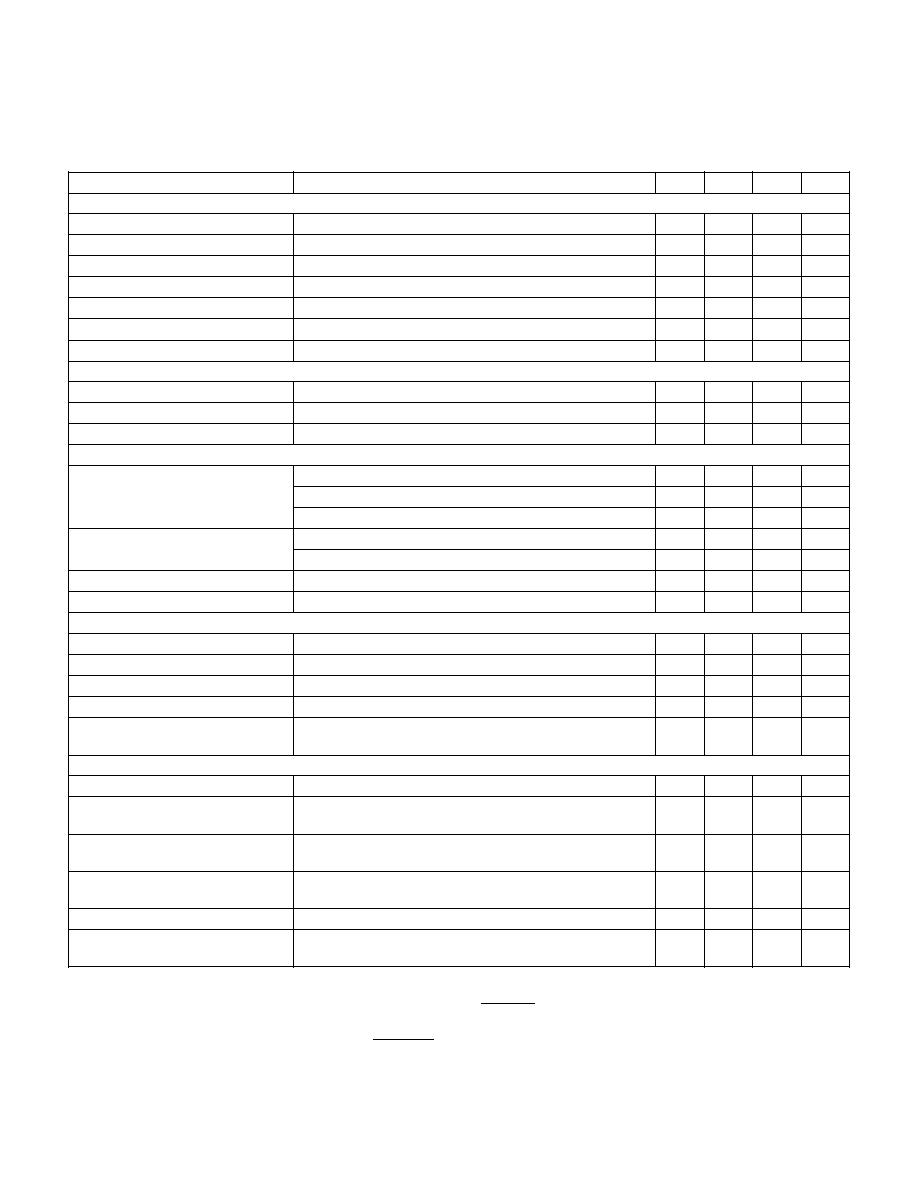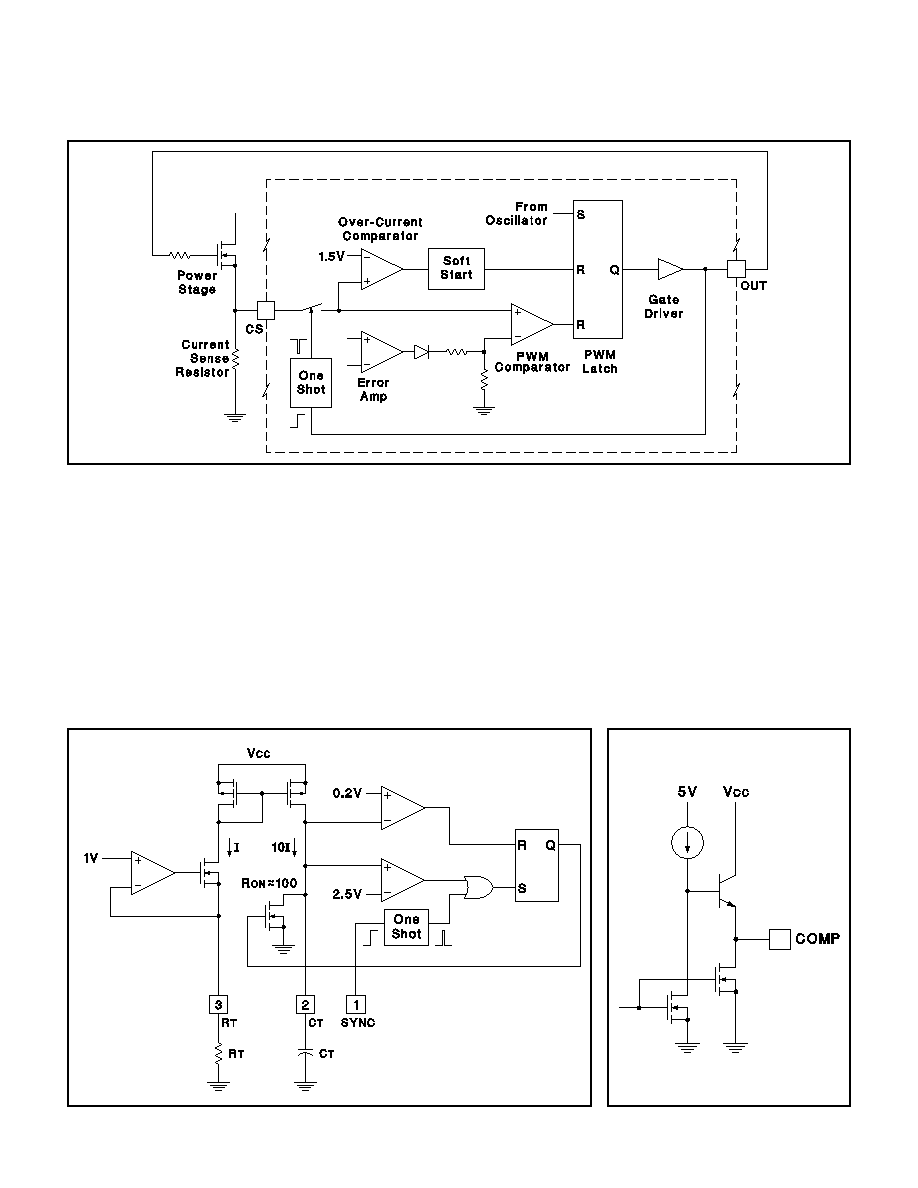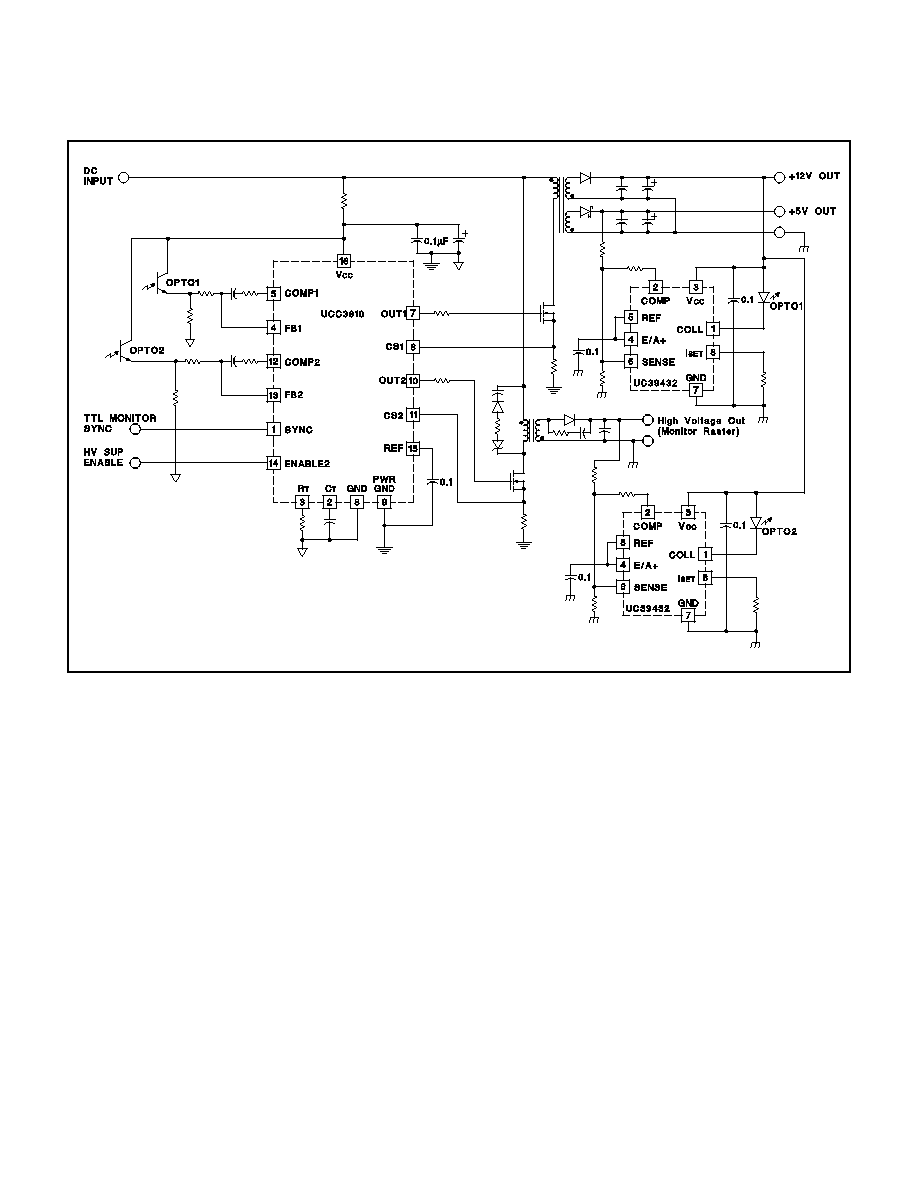 | –≠–ª–µ–∫—Ç—Ä–æ–Ω–Ω—ã–π –∫–æ–º–ø–æ–Ω–µ–Ω—Ç: UCC1810 | –°–∫–∞—á–∞—Ç—å:  PDF PDF  ZIP ZIP |

UCC1810
UCC2810
UCC3810
02/99
FEATURES
∑
Single Oscillator Synchronizes Two
PWMs
∑
150 A Startup Supply Current
∑
2mA Operating Supply Current
∑
Operation to 1MHz
∑
Internal Soft Start
∑
Full-Cycle Fault Restart
∑
Internal Leading Edge Blanking of the
Current Sense Signal
∑
1 Amp Totem Pole Outputs
∑
75ns Typical Response from Current
Sense to Output
∑
1.5% Tolerance Voltage Reference
DESCRIPTION
The UCC3810 is a high-speed BiCMOS integrated circuit which imple-
ments two synchronized pulse width modulators for use in off-line and
DC-to-DC power supplies.
The UCC3810 provides perfect synchronization between two PWMs by us-
ing the same oscillator. The oscillator's sawtooth waveform can be used for
slope compensation if required.
Using a toggle flip flop to alternate between modulators, the UCC3810 en-
sures that one PWM will not slave, interfere, or otherwise affect the other
PWM. This toggle flip flop also ensures that each PWM will be limited to
50% maximum duty cycle, insuring adequate off-time to reset magnetic el-
ements.
This IC contains many of the same elements of the UC3842 current mode
controller family, combined with the enhancements of the UCC3802. This
minimizes power supply parts count. Enhancements include leading edge
blanking of the current sense signals, full cycle fault restart, CMOS output
drivers, and outputs which remain low even when the supply voltage is re-
moved.
Dual Channel Synchronized Current Mode PWM
BLOCK DIAGRAM
UDG-92062-1

2
UCC1810
UCC2810
UCC3810
ABSOLUTE MAXIMUM RATINGS
V
CC
Voltage (Note 3) . . . . . . . . . . . . . . . . . . . . . . . . . . . . . . 11V
V
CC
Current . . . . . . . . . . . . . . . . . . . . . . . . . . . . . . . . . . . 20mA
OUT1, OUT2 Current, Peak, 5% Duty Cycle. . . . . . . . . . . .
±
1A
OUT1, OUT2 Energy (Capacitive Load) . . . . . . . . . . . . . . 20
µ
J
Analog Inputs (FB1, FB2, CS1, CS2, SYNC). . . . ≠0.3V to 6.3V
Operating Junction Temperature . . . . . . . . . . . . . . . . . . +150
∞
C
Storage Temperature Range . . . . . . . . . . . . . ≠65
∞
C to +150
∞
C
Lead Temperature (Soldering, 10 seconds) . . . . . . . . . . 300
∞
C
Note 1: All voltages are with respect to GND. All currents are
positive into the specified terminals.
Note 2: Consult Unitrode Integrated Circuits Product & Appli-
cations Handbook for information regarding thermal
specifications and limitations of packages.
Note 3: In normal operation, V
CC
is powered through a current
limiting resistor. Absolute maximum of 11V applies
when driven from a low impedance such that the V
CC
current does not exceed 20mA.
CONNECTION DIAGRAM
ELECTRICAL CHARACTERISTICS:
Unless otherwise stated, these specifications apply for ≠55
∞
C
T
A
125
∞
C for
UCC1810; ≠40
∞
C
T
A
85
∞
C for UCC2810; 0∞C
T
A
70∞C for UCC3810; V
CC
= 10V (Note 4); R
T
= 150k; C
T
= 120pF;
No Load; T
A
= T
J
. All parameters are the same for both channels.
PARAMETER
TEST CONDITIONS
MIN
TYP
MAX
UNITS
Reference Section
Output Voltage
T
J
= 25
∞
C
4.925
5.000
5.075
V
Load Regulation
0mA < I
REF
< 5mA
5
25
mV
Line Regulation
UVLO Stop Threshold Voltage +0.5V < V
CC
< Shunt
Voltage
12
mV
Output Voltage
Full temperature range, 0mA < I
REF
< 5mA
4.85
5.00
5.10
V
Output Noise Voltage
10Hz < f < 10kHz, T
J
= +25
∞
C (Note 10)
235
µ
V
Long Term Stability
T
A
= +125
∞
C, 1000 Hours (Note 10)
5
mV
Output Short Circuit Current
≠8
≠25
mA
Oscillator Section
Oscillator Frequency
R
T
= 30k, C
T
= 120pF (Note 5)
840
940
1040
kHz
Oscillator Frequency
R
T
= 150k, C
T
= 120pF (Note 5)
200
220
240
kHz
Temperature Stability
(Note 10)
2.5
%
Peak Voltage
2.5
V
Valley Voltage
0.05
V
Peak-to-Peak Amplitude
2.25
2.45
2.65
V
SYNC Threshold
0.80
1.65
2.2
V
SYNC Input Current
SYNC = 5V
30
µ
A
Error Amplifier Section
FB Input Voltage
COMP = 2.5V
2.44
2.50
2.56
V
FB Input Bias Current
±
1
µ
A
Open Loop Voltage Gain
60
73
dB
Unity Gain Bandwidth
(Note 10)
2
MHz
COMP Sink Current
FB = 2.7V, COMP = 1V
0.3
1.4
3.5
mA
COMP Source Current
FB = 1.8V, COMP = 4V
≠0.2
≠0.5
≠0.8
mA
Minimum Duty Cycle
COMP = 0V
0
%
COMP Soft Start Rise Time
FB = 1.8V, Rise from 0.5V to REF≠1.5V
5
ms
DIL-16, SOIC-16 (TOP VIEW)
J or N Package, DW Package

3
UCC1810
UCC2810
UCC3810
ELECTRICAL CHARACTERISTICS:
Unless otherwise stated, these specifications apply for ≠55
∞
C
T
A
125
∞
C for
UCC1810; ≠40
∞
C
T
A
85
∞
C for UCC2810; 0∞C
T
A
70∞C for UCC3810; V
CC
= 10V (Note 4); R
T
= 150k; C
T
= 120pF;
No Load; T
A
= T
J
. All parameters are the same for both channels.
PARAMETER
TEST CONDITIONS
MIN
TYP
MAX
UNITS
Current Sense Section
Gain
(Note 6)
1.20
1.55
1.80
V/V
Maximum Input Signal
COMP = 5V (Note 7)
0.9
1.0
1.1
V
CS Input Bias Current
±
200
nA
CS to OUT Propagation Delay
CS steps from 0V to 1.2V, COMP = 2.5V
75
ns
CS Blank Time
(Note 8)
55
ns
CS Overcurrent Threshold
1.35
1.55
1.85
V
COMP to CS Offset
CS = 0V
0.65
0.95
1.4
V
PWM Section
Maximum Duty Cycle
R
T
= 150k, C
T
= 120pF (Note 10)
45
49
50
%
Maximum Duty Cycle
R
T
= 30k, C
T
= 120pF (Note 10)
40
45
48
%
Minimum On Time
CS =1.2V, COMP = 5V
130
ns
Output Section
OUT Low Level
I
OUT
= 20mA
0.12
0.42
V
I
OUT
= 200mA
0.48
1.10
V
I
OUT
= 20mA, V
CC
= 0V
0.7
1.20
V
OUT High Level
(V
CC
- OUT)
I
OUT
= ≠20mA
0.15
0.42
V
I
OUT
= ≠200mA
1.20
2.30
V
OUT Rise Time
C
OUT
= 1nF
20
50
ns
OUT Fall Time
C
OUT
= 1nF
30
60
ns
Undervoltage Lockout Section
Start Threshold
9.9
11.3
13.2
V
Stop Threshold
7.5
8.3
9.5
V
Start to Stop Hysteresis
1.7
3.0
4.7
V
ENABLE2 Input Bias Current
ENABLE2 = 0V
≠20
≠35
≠55
µ
A
ENABLE2 Input Threshold
Voltage
0.80
1.53
2.00
V
Overall Section
Startup Current
V
CC
< Start Threshold Voltage
0.15
0.25
mA
Operating Supply Current,
Outputs Off
V
CC
= 10V, FB = 2.75V
2.0
3.0
mA
Operating Supply Current,
Outputs On
V
CC
= 10V, FB = 0V, CS = 0V, R
T
= 150k
3.2
5.1
mA
Operating Supply Current,
Outputs On
V
CC
= 10V, FB = 0V, CS = 0V, R
T
= 30k
8.5
14.5
mA
V
CC
Internal Zener Voltage
I
CC
= 10mA (Note 9)
11.0
12.9
14.0
V
V
CC
Internal Zener Voltage Minus
Start Threshold Voltage
0.4
1.2
V
Note 4: Adjust V
CC
above the start threshold before setting at 10V.
Note 5: Oscillator frequency is twice the output frequency.
F
RT
CT
OSC
◊
4
Note 6: Current Sense Gain A is defined by:
A
VCOMP
VCS
VCS
V
=
0
0 8
.
.
Note 7: Parameter measured at trip point of latch with FB = 0V.
Note 8: CS Blank Time is measured as the difference between the minimum non-zero on-time and the CS to OUT delay.
Note 9: Start Threshold Voltage and V
CC
Internal Zener Voltage track each other.
Note 10: Guaranteed by design. Not 100% tested in production.

4
UCC1810
UCC2810
UCC3810
PIN DESCRIPTIONS
COMP1, COMP2: The low impedance outputs of the er-
ror amplifiers.
CS1, CS2: The current sense inputs to the PWM com-
parators. These inputs have leading edge blanking. For
most applications, no input filtering is required. Leading
edge blanking disconnects the CS inputs from all inter-
nal circuits for the first 55ns of each PWM cycle. When
used with very slow diodes or in other applications
where the current sense signal is unusually noisy, a
small current sense RC filter may be required.
CT: The timing capacitor of the oscillator. Recom-
mended values of C
T
are between 100pF and 1nF. Con-
nect the timing capacitor directly across C
T
and GND.
ENABLE2: A logic input which disables PWM 2 when
low. This input has no effect on PWM 1. This input is in-
ternally pulled high. In most applications it can be left
floating. In unusually noisy applications, the input should
be bypassed with a 1nF ceramic capacitor. This input
has TTL compatible thresholds.
FB1, FB2: The high impedance inverting inputs of the
error amplifiers.
GND: To separate noise from the critical control circuits,
this part has two different ground connections: GND and
PWRGND. GND and PWRGND must be electrically
connected together. However, use care to avoid cou-
pling noise into GND.
OUT1, OUT2: The high current push-pull outputs of the
PWM are intended to drive power MOSFET gates
through a small resistor. This resistor acts as both a cur-
rent limiting resistor and as a damping impedance to
minimize ringing and overshoot.
PWRGND: To separate noise from the critical control
circuits, this part has two different ground connections:
GND and PWRGND. GND and PWRGND must be elec-
trically connected together.
REF: The output of the 5V reference. Bypass REF to
GND with a ceramic capacitor
0.01
µ
F for best perfor-
mance.
RT: The oscillator charging current is set by the value of
the resistor connected from R
T
to GND. This pin is regu-
lated to 1V, but the actual charging current is 10V/R
T
.
Recommended values of R
T
are between 10k and 470k.
For a given frequency, higher timing resistors give
higher maximum duty cycle and slightly lower overall
power consumption. Supply current decreases with in-
creased R
T
by the relationship:
ICC
V
RT
=
11
For more information, see the detailed oscillator block
diagram.
SYNC: This logic input can be used to synchronize the
oscillator to a free running oscillator in another part. This
pin is edge triggered with TTL thresholds, and requires
at least a 10ns wide pulse. If unused, this pin can be
grounded, open circuited, or connected to REF.
VCC: The power input to the IC. This pin supplies cur-
rent to all functions including the high current output
stages and the precision reference. Therefore, it is criti-
cal that V
CC
be directly bypassed to PWRGND with an
0.1
µ
F ceramic capacitor.
Leading Edge Blanking and Current Sense
Figure 1. shows how an external power stage is con-
nected to the UCC3810. The gate of an external power
N-channel MOSFET is connected to OUT through a
small current limiting resistor. For most applications, a
10
resistor is adequate to limit peak current and also
practical at damping resonances between the gate driver
and the MOSFET input reactance. Long gate lead length
increases gate capacitance and mandates a higher se-
ries gate resistor to damp the RLC tank formed by the
lead, the MOSFET input reactance, and the UCC3810
driver output resistance.
The UCC3810 features internal leading edge blanking of
the current sense signal on both current sense inputs.
The blank time starts when OUT rises and continues for
55ns. During that 55ns period, the signal on CS is ig-
nored. For most PWM applications, this means that the
CS input can be connected to the current sense resistor
as shown above. However, high speed grounding prac-
tices and short lead lengths are still required for good
performance.
APPLICATION INFORMATION

5
UCC1810
UCC2810
UCC3810
Figure 1. Detailed block diagram.
APPLICATION INFORMATION (cont.)
Oscillator
The UCC3810 oscillator generates a sawtooth wave at
CT. The sawtooth rise time is set by the resistor from RT
to GND. Since RT is biased at 1V, the current in RT is
1V/RT. The actual charging current is 10 times higher.
The fall time is set by an internal transistor on-resistance
of approximately 100
. During the fall time, all outputs
are off and the maximum duty cycle is reduced below
50%. Larger timing capacitors increase the discharge
time and reduce frequency. However, the percentage
maximum duty cycle is only a function of the timing resis-
tor RT and the internal 100
discharge resistance.
Error Amp Output Stage
The UCC3810 error amplifiers are operational amplifiers
with low output resistance and high input resistance. The
output stage of one error amplifier is shown above. This
output stage allows the error amplifier output to swing
close to GND and as high as one diode drop below 5V
with little loss in amplifier performance.
Figure 2. Oscillator.
Figure 3. Error amp output stage.

6
UCC1810
UCC2810
UCC3810
Figure 9. Maximum duty cycle vs. frequency.
Figure 5. Oscillator frequency vs. temperature.
Figure 7. Oscillator frequency vs. R
T
and C
T.
Figure 8. Maximum duty cycle vs R
T.
Figure 4. Error amp and gain phase response.
TYPICAL CHARACTERISTICS
Figure 6. I
CC
vs. oscillator frequency.

7
UCC1810
UCC2810
UCC3810
UNITRODE CORPORATION
7 CONTINENTAL BLVD. ∑ MERRIMACK, NH 03054
TEL. (603) 424-2410 FAX (603) 424-3460
APPLICATION INFORMATION (cont.)
Figure 10. Typical application.
UDG-94022

IMPORTANT NOTICE
Texas Instruments and its subsidiaries (TI) reserve the right to make changes to their products or to discontinue
any product or service without notice, and advise customers to obtain the latest version of relevant information
to verify, before placing orders, that information being relied on is current and complete. All products are sold
subject to the terms and conditions of sale supplied at the time of order acknowledgement, including those
pertaining to warranty, patent infringement, and limitation of liability.
TI warrants performance of its semiconductor products to the specifications applicable at the time of sale in
accordance with TI's standard warranty. Testing and other quality control techniques are utilized to the extent
TI deems necessary to support this warranty. Specific testing of all parameters of each device is not necessarily
performed, except those mandated by government requirements.
CERTAIN APPLICATIONS USING SEMICONDUCTOR PRODUCTS MAY INVOLVE POTENTIAL RISKS OF
DEATH, PERSONAL INJURY, OR SEVERE PROPERTY OR ENVIRONMENTAL DAMAGE ("CRITICAL
APPLICATIONS"). TI SEMICONDUCTOR PRODUCTS ARE NOT DESIGNED, AUTHORIZED, OR
WARRANTED TO BE SUITABLE FOR USE IN LIFE-SUPPORT DEVICES OR SYSTEMS OR OTHER
CRITICAL APPLICATIONS. INCLUSION OF TI PRODUCTS IN SUCH APPLICATIONS IS UNDERSTOOD TO
BE FULLY AT THE CUSTOMER'S RISK.
In order to minimize risks associated with the customer's applications, adequate design and operating
safeguards must be provided by the customer to minimize inherent or procedural hazards.
TI assumes no liability for applications assistance or customer product design. TI does not warrant or represent
that any license, either express or implied, is granted under any patent right, copyright, mask work right, or other
intellectual property right of TI covering or relating to any combination, machine, or process in which such
semiconductor products or services might be or are used. TI's publication of information regarding any third
party's products or services does not constitute TI's approval, warranty or endorsement thereof.
Copyright
©
1999, Texas Instruments Incorporated







